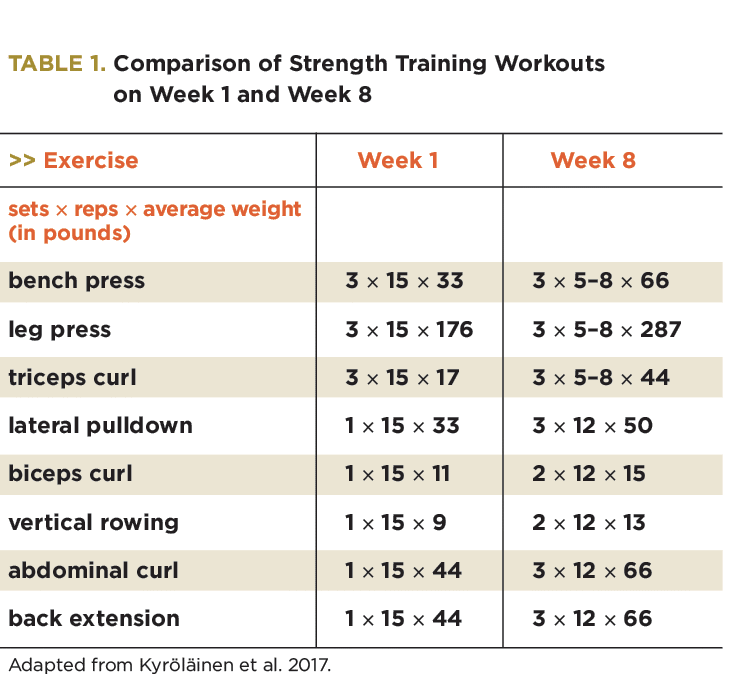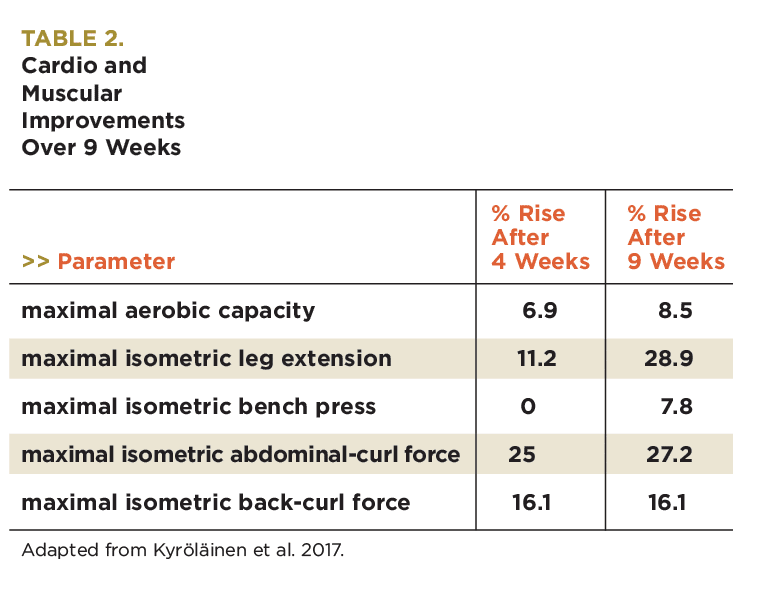Training Guidance for Sedentary Young Women
A 2017 study shows the health benefits of combining cardiovascular and strength training for women early in their careers.
| Earn 1 CEC - Take Quiz

Study reviewed: Kyröläinen, H., et al. 2017. Effects of combined strength and endurance training on physical performance and biomarkers of healthy young women. The Journal of Strength and Conditioning Research, 32 (6), 1554–61.
Researchers know a lot about improving muscular strength and cardiovascular endurance in college-age students, since they often participate in fitness studies. But scientists don’t know so much about sedentary women aged 25–30, most of whom are transitioning from college to work. Kyröläinen et al. (2017) set out to narrow this knowledge gap.
The researchers noted that many working women in the 25–30 age group struggle to find time to meet exercise recommendations from groups like the World Health Organization and Centers for Disease Control and Prevention. Moreover, there is little published research on optimal training volumes and exercise progressions for these women.
Kyröläinen’s project helps clarify things. The team’s research found that a combined cardiovascular endurance and muscular strength program improved several parameters of health and well-being in sedentary young women. The study focused solely on the impact of exercise—there was no nutritional component beyond monitoring the volunteers’ diets.
Participants
Seventeen sedentary women who worked primarily in office jobs volunteered for the study. The women (aged 25–30; 65% with overweight or obesity; 29% with normal weight; 6% who were underweight) were instructed not to begin any other sports activities or exercise programs during the 9 weeks of the study. Kyröläinen’s team provided no dietary intervention, but participants were encouraged to maintain their current diets and asked to complete 3-day food diaries (with one weekend day) for every week of the study.
Testing and Tracking
The research team gathered various measurements before, during and after the training period.
Aerobic capacity. Using a cycle ergometer, each participant began with a 75-watt load, which increased by 25 watts every 2 minutes until she reached exhaustion.
Maximal strength. The subjects’ maximal isometric leg extension and arm extension forces were measured at the midpoint of movement on a leg press and bench press. They also did a 1-repetition maximum and a 10-RM set of full-range-of-motion leg extension. A strain gauge measured force in the abdominal and back muscles in a fixed vertical position.
Participants completed maximal isometric extension for the back (3-second hold) and flexion for the abdominals.
Lab tests. Blood samples documented participants’ levels of total cholesterol, high-density lipoprotein cholesterol, low-density lipoprotein cholesterol, glucose, triglycerides (blood fats), testosterone, cortisol and estradiol.
Body composition. Bio-electrical impedance analysis determined electrical opposition to the flow of an electric current through body tissues. The test estimates total body water, which predicts the percentages of fat and muscle in the body.
Training Program
The women trained three times a week for 9 weeks. For each of the first 7 weeks, they did two strength training workouts (updated each week with individualized training guidelines) and one cardiovascular training session.
In the last 2 weeks, they did two cardiovascular endurance workouts and one strength training session per week.
The cardio workouts started with 30 minutes of researcher-led indoor cycling, progressing to 55 minutes by the end of the 9-week study. The women trained at 85%–91% of maximal oxygen uptake, which is a hard-to-very-hard exercise intensity.
For the resistance training program, Table 1 shows the exercises, sets, repetitions and average loads in week 1 and week 8. The recovery interval between sets was 45–60 seconds at the start of the training. As intensity increased over the course of the study, recovery progressed to 120–150 seconds. Notice the progression in sets, repetitions, intensity and load shown in the table.
Results and Discussion
The researchers tested participants at the start of the study, at the midpoint (after 4 weeks) and after the 9-week program (see Table 2). Midpoint testing provided intriguing insight into the timing of their physical adaptations. For instance, while maximal aerobic capacity increased by an average of 8.5% by week 9, it had already risen 6.9% by week 4. This is a fascinating result because participants completed only one cardio workout a week in those first 4 weeks. Kyröläinen et al. said previous 12- to 14-week studies with similar sedentary populations produced approximately 13%–20% increases in maximal aerobic capacity. Naturally, initial fitness level, exercise training intensity, weekly frequency and weekly duration all factor into the varying degrees of aerobic improvement.
Maximal isometric leg extensor strength increased 28.9% in the 9 weeks, with an 11.2% improvement occurring by week 4. In contrast, the study noted an average maximal isometric bench press increase of 7.8%, but that change occurred after midpoint testing. Thus, the 4-week measurements show that upper- and lower-body adaptations happened at different times in this sedentary group of women.
Full-range-of-motion leg extension increased 32% in the 1-RM and 46% in the 10-RM. Isometric abdominal-curl force bumped up 27.2% by week 9, but by week 4 the increase was already 25%. Similarly, maximal back-curl force increased 16.1% by the midpoint, with no additional improvement during the next 5 weeks of the study. Once again, this midpoint measurement provides interesting data on the timing and magnitude of adaptation in the early weeks of training.
The blood parameter research in this study reveals significant health implications. The study found an 8.8% increase in good cholesterol (high-density lipoprotein cholesterol, or HDL-C) by week 9, a promising outcome. Researchers also noted a 7.6% decrease in total cholesterol. Testosterone, glucose and estradiol levels did not change. Note that the weekly food diaries showed no changes in total food intake or in daily percentages of fat, carbohydrate and protein over the 9 weeks of the study.
Another interesting finding was a 22.7% increase in cortisol after 9 weeks. The researchers hypothesized that this increase may have been a benefit of improved fat metabolism from the training, since cortisol is a key hormone for regulating fat breakdown.
As for body composition, the project found no meaningful change in percent muscle mass (pretest: 26.4%; posttest: 26.6%) or percent body fat (pretest: 32.8%; posttest: 32.0%). Kyröläinen et al. note that previous studies showed more noteworthy improvements in body composition when calorie and macronutrient changes accompanied the exercise program. This investigation had a different goal: observing the combined effects of cardiovascular exercise and resistance training on all the parameters measured.
Promising Results
Though the study lacked a control group, Kyröläinen et al. minimized this limitation by completing two pretest periods 1 week apart to establish stable baseline measurements of all variables. From a health perspective, the study results support known benefits of physical activity, including reduced risk for cardiovascular disease, hypertension, type 2 diabetes, stroke and other chronic health conditions (McKinney et al. 2016). And perhaps some of the most compelling findings were the midpoint measurements—revealing how quickly this population of sedentary women showed health improvements. That is really encouraging news.
The women trained three times a week for 9 weeks. For each of the first 7 weeks, they did two strength training workouts (updated each week with individualized training guidelines) and one cardiovascular training session.
In the last 2 weeks, they did two cardiovascular endurance workouts and one strength training session per week.
The cardio workouts started with 30 minutes of researcher-led indoor cycling, progressing to 55 minutes by the end of the 9-week study. The women trained at 85%–91% of maximal oxygen uptake, which is a hard-to-very-hard exercise intensity.
For the resistance training program, Table 1 shows the exercises, sets, repetitions and average loads in week 1 and week 8. The recovery interval between sets was 45–60 seconds at the start of the training. As intensity increased over the course of the study, recovery progressed to 120–150 seconds. Notice the progression in sets, repetitions, int
References
McKinney, J., et al. 2016. The health benefits of physical activity and cardiorespiratory fitness. British Columbia Medical Journal, 58 (3), 131–37.
Len Kravitz, PhD
Len Kravitz, PhD is a professor and program coordinator of exercise science at the University of New Mexico where he recently received the Presidential Award of Distinction and the Outstanding Teacher of the Year award. In addition to being a 2016 inductee into the National Fitness Hall of Fame, Dr. Kravitz was awarded the Fitness Educator of the Year by the American Council on Exercise. Just recently, ACSM honored him with writing the 'Paper of the Year' for the ACSM Health and Fitness Journal.








